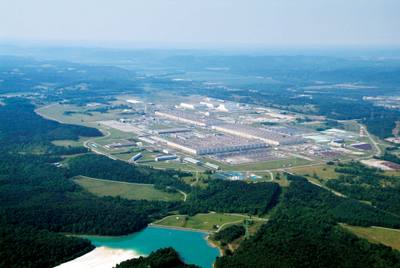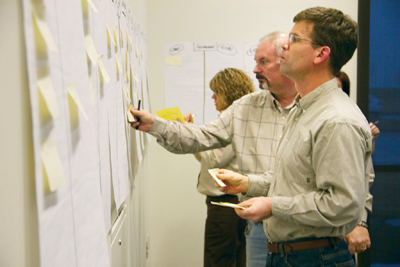Second Life: Citizens, scholars seek new uses for a former government energy plant
When the federal government decided to cease operations at a massive facility that supplied enriched uranium to the nuclear weapons and energy industry, it was left with a dilemma: What should it do with the 3,777-acre site that once provided more than 20,000 jobs to residents of rural southern Ohio during the height of the Cold War?
To gather citizen input on the question, as well as to help with the environmental cleanup of the Portsmouth Gaseous Diffusion Plant (PORTS) in Piketon, the U.S. Department of Energy (DOE) awarded a $2.4 million grant to Ohio University's Voinovich School of Leadership and Public Affairs. The university is managing various public outreach and applied environmental science tasks that support the ongoing decontamination and decommission activities at the site.
The project is a good fit for the Voinovich School's unique mix of expertise in public policy and outreach, energy, environment, and administration issues, says Stephanie Howe, the school's associate director of human capital and operations.
"This project is typical of what we do—solving problems," she says. "The project will benefit the public by providing information to the DOE that should allow the cleanup to occur faster, better, and cheaper, so that that the facility can be repurposed for other industrial use that will benefit surrounding communities."
|
|
The PORTS site covers 3,777 acres in southern Ohio. (Photo courtesy of the Voinovich School of Leadership and Public Affairs)
PORTS was one of three gaseous diffusion plants built by the U.S. Atomic Energy Commission during the 1940s and 1950s. The other two are in Oak Ridge, Tennessee, and Paducah, Kentucky. The DOE currently is involved in a similar public outreach and environmental remediation project at the Kentucky site.
The Ohio plant operated from 1954 to 2001, when the lessee ceased uranium enrichment operations. In 2005, the DOE placed the plant in "cold shutdown" status in preparation for the decontamination and decommissioning of the site.
A major part of the project, called PORTSfuture, was a 15-month public outreach program in Pike, Scioto, Ross, and Jackson counties, which had "provided the largest labor force for the site," explains Michele Morrone, associate professor of environmental health. During construction in 1954, up to 20,000 workers were on site. The ongoing enrichment operation supported about 2,500 employees.
The project team first interviewed eight key individuals, such as local officials, former employees, and environmentalists who were knowledgeable about PORTS and interested in what would replace it. These individuals described how the plant was perceived in the region and what issues they feel their communities faced.
In the next few stages of the public outreach, which included focus groups recruited via newspaper ads and county fairs, as well as a random phone survey of 1,000 people, many residents expressed that the need for jobs was the region's most pressing issue, Morrone says. A media content analysis of 20 years' worth of local papers, including the Portsmouth Daily Times, had similar results. Of more than 200 articles about the Portsmouth plant, the "overwhelming majority" were about jobs and the economy, she says.
Today, about 2,000 residents have jobs at PORTS, most of them part of the DOE's ongoing decontamination and decommission efforts. Unemployment in the four-county region is higher than in other parts of Ohio. In April 2012, Pike County had an unemployment rate 13.5 percent, the highest in the state. One woman at a focus group talked about how her sons would have to move out of the area to find work. "She was visibly upset as she talked about how her family was going to be split up because there were no jobs" in the community, Morrone says.
In March 2011, the project team, which included Voinovich School personnel and faculty in the Department of Social and Public Health, coordinated meetings in Portsmouth and Chillicothe to engage residents in brainstorming new uses for the site. During these sessions, the only portions of the former plant that couldn't be considered for new uses were the acreage currently used to safely process and dispose of depleted uranium contained in uranium storage cylinders, and an area leased to a private company that is developing a new energy-efficient uranium-enrichment process.
After eight county-level meetings, hundreds of ideas were presented to an advisory group that narrowed them to nine future-use scenarios. Guided by an economic forecast of the jobs and other financial benefits each use would bring, which was prepared by the Voinovich School and Department of Economics researchers, the group members ranked the scenarios. Next, residents of the four-county region were asked to vote for their top three choices, either online or at 2011 county fair booths. (During voting, residents also had access to the jobs/economic forecast.) Out of approximately 213,000 people in the four-county region, 1,100 voted.
The most popular future-use scenario, with 495 votes, was a nuclear power plant, followed closely by green energy production (475 votes). An industrial park was the third choice (421 votes), with a national research and development facility coming in fourth (418 votes).
However, the public's top choice—or even its second—isn't a shoo-in for PORTS, Morrone says. "It's up to the DOE to decide what to do with the report," she says, adding that the project team made sure participants in the process were aware that the report was one of several inputs into the future-use decision.
Ohio University sought citizen input about the future uses of the PORTS site. (Photo courtesy of Voinovich School)
In the meantime, another portion of the DOE grant is being used to perform environmental tasks that will help the agency and its contractor with the decontamination and decommission process, says Natalie Kruse, an assistant professor of environmental studies in the Voinovich School. "One of our projects is a habitat assessment," she says. "We look at which habitats are most important for endangered plant and animal species, which habitats are most important to preserve."
The scientific team also is testing soil samples using field instruments to develop and demonstrate a cost-effective method to determine the contamination levels of polychlorinated biphenyls (PCBs), a now-banned chemical that was used in industry prior to 1979. "We're looking at how those PCBs change and age in the soils and the sediments," Kruse says. "We're working on developing methods to analyze those compounds on the field using a portable machine."
In addition, researchers provided an independent review of the models DOE uses for groundwater remediation at the site.
Joel Bradburne, Portsmouth site lead for the DOE, says the cleanup of PORTS, which is expected to cost billions, is governed primarily by two federal acts dealing with hazardous substance removal and environmental recovery. Dependent on funding, the earliest that the site could be remediated is 2024, he says, although it's possible that some parts of the site could be put to a new use while other parts of the site are still being cleaned up.
Other aspects of the Voinovich project, which currently runs through December 2012, included the making of a documentary film of the public participation process and conducting training sessions on topics of interest to the public, including environmental sampling methods and contaminant analysis. The team also guided Piketon High School students in synthesizing and writing a layman's summary of the 2009 U.S. DOE Annual Site Environmental Report for PORTS.
In addition to its impact in southern Ohio, the Voinovich School envisions that the lessons of the PORTSfuture project could reach beyond the borders of the Buckeye state. "This could be a national model," Howe says, "for how to do grassroots outreach in a rural area struggling with economic issues."
This article appeared in the Autumn/Winter 2012 issue of Perspectives magazine.

